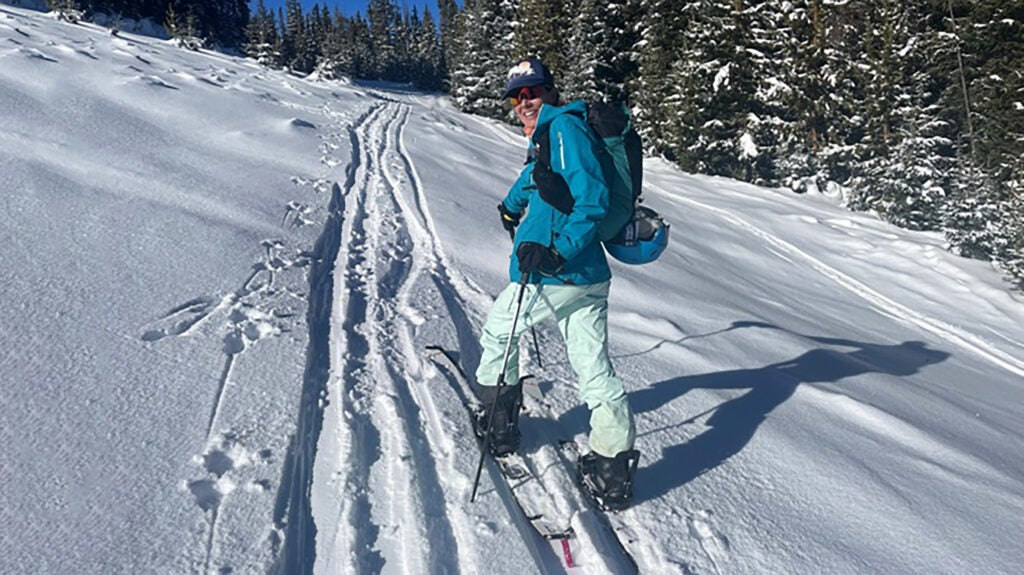No products in the cart.
Outdoor Adventure
My New Splitboard Sometimes Frightens and Frustrates Me—That’s One Reason I Love It
Heading out the door? Read this article on the Outside app available now on iOS devices for members!
Download the app.
It is fairly terrifying to trust a strip of fuzzy fabric to keep you from careening backwards down a steep, snowy ski hill while trying to climb up it. That fuzz’s friction is all I could think about the first time I splitboarded up Steamboat, Colorado’s blue runs at seven a.m. while my family was still nestled in their beds in the condo nearby. I had only ever splitboarded once before on demo gear, so I was putting a lot of faith in my new Pomoca Free Pro 2.0 skins affixed to the bottom of my 2022-23 WNDR Alpine Belle Tour splitboard that I’d just bought myself for Christmas.
For the uninitiated, a splitboard is a snowboard that splits into two halves (that almost look like skis). Attach climbing skins to the bottom of each half, and you can walk uphill; when you get to the top of your climb, rip the skins off and reconnect the board into one piece to snowboard downhill like on any regular snowboard. Most use splitboards for accessing backcountry powder, but they can also be used inbounds at resorts that allow uphilling. Though I’d ski toured (walking uphill on skis) a few times, I’m a terrible downhill skier and have been snowboarding for 20+ years.
My new toy had me giddy at the thought of getting in a workout while going uphill, and carving sweet turns on the down on my preferred type of plank. I like to say a splitboard is the Transformer of winter equipment, an analogy my younger son doesn’t appreciate as much as I think he should.
That first morning in Steamboat, I’d intended to go up the easy, green-run route for a bit and turn around. That was the plan, but my inner endurance junkie spotted a fit guy heading up a steeper route, and so I followed. And when he disappeared over the crest of the hill, I continued to follow. I ended up climbing a second steep run, praying to God, Mother Nature, and the Patron Saint of Reliable Gear that I’d both affixed my skins correctly, and that they’d grip the snow as I climbed and traversed.
Miraculously, the skins did what skins are supposed to do, the fuzzy side grabbing hold of the snow and giving me traction. (Skins remind me of petting a dog in the wrong direction of their fur; it’s the wrong-way “fur” that takes hold.) I managed to make it to the Thunderhead Lodge after a 1.7-mile, 2,119-foot climb that left me both exhausted and exhilarated.
At the top, I got a call from my doctor that I hadn’t, in fact, torn my MCL from trying to tackle my teenage son in my kitchen a week prior (I got an MRI the day we drove to Steamboat). I had KT Taped and braced my knee for the morning skin up, but the wobbly knee had contributed to my worry, making reliable skins even more critical. It was going to be a great day!

That morning, and on a few more outings, I struggled a bit with transitioning my board from two climbing planks to one rideable snowboard. I had to pull off the sticky skins, stick them to the plastic strip they come attached to (more experienced splitboarders than I skip this step and stick skins to each other), and shove them in my pack. I then had to convert my Spark R&D ARC ST bindings (which I’d also gifted myself; I was really good last year) from walk- to ride-mode. This involves sliding the bindings off their base—a rather ingenious contraption—to face sideways for snowboarding downhill rather than forward, as they do for walking uphill on the split planks. This step was smooth, only because the two guys at my local shop spent hours sanding down the base for me. (Spark’s website says setting up the base for a smooth glide might require someone to “sand lightly.” The extra sanding could have been due to an alignment set-up issue.) And yes, I owe Matt and Mason at Epic Sports a case of beer.
But there was some futzing and swearing during the transformation of the system during a snow-dump of an outing, when I just wanted to cruise the powder after my climb and couldn’t efficiently get the board connected. Four clips connect the board in the middle, but it can be challenging to get the two pieces aligned perfectly so there’s no middle edge to catch.
As I sweated and swore, I reminded myself that frustration is just part of learning how to use new gear, which is good and healthy. Neuroscience has told us that learning new skills can ward off memory loss and dementia, give us confidence, and contribute to our overall happiness. Besides the thrill of learning to trust the skins on the steeps, and the satisfaction of mastering the challenge of assembling my bindings and transformer board, I got an additional reward from my new skills: making buttery turns in untouched powder before the lifts start spinning.
As a “seasoned” (a euphemism) gear reviewer and adventure athlete, being challenged to learn a new setup, system, or toy feels especially rewarding and healthy. It’s put me to the test in an area I thought I had mastered long ago: outdoor gear.
The next challenge is to take an avalanche awareness course before I hit the backcountry and ride out-of-bounds terrain beyond low-angle slopes in the trees. I might enroll in one this spring. But so far this winter, these new toys—and figuring out how to use them—have put a powder-eating grin on my face.
Source link

